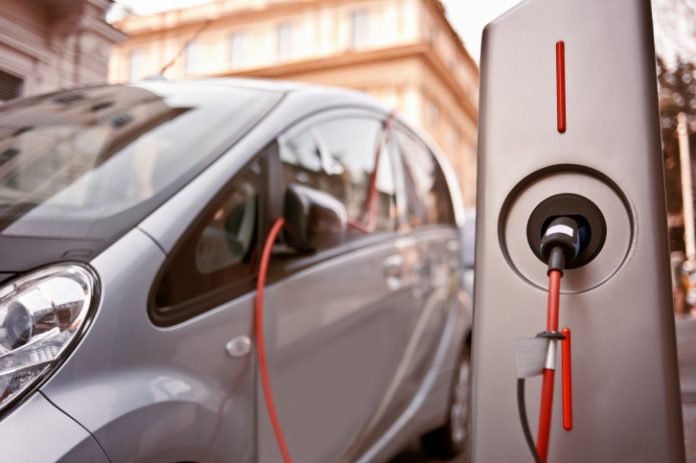A new federal joint office is being created to oversee spending of $7.5 billion to build out a national electric vehicle (EV) charging network, contained in the Infrastructure and Jobs Act written passed by Congress in mid-November 2021.
The law proposes to construct 500,000 charging stations linked to the electric grid nationwide, making electric vehicles more accessible. It also sets aside $5 billion for states to pursue this goal and provides $2.5 billion in grаnts to help build EV chаrging stations in rural areas and in underserved communities.
The administration has said it recognizes widespread adoption of EVs is hampered by limited charging locations. This provision of the infrastructure bill aims to reduce barriers to EV adoption.
DOE and DOT Cooperate
Jennifer M. Granholm, secretary of the U.S. Department of Energy, and Pete Buttigieg, secretary of the U.S. Department of Transportation, signed a memorandum of understanding in December 2021 to create a Joint Office of Energy and Transportation (JOET) to oversee the EV infrastructure build-out.
“We are embarking on a transformative path to modernize the way we get to around in this country, making sure all Americans have the option to choose electric vehicles and spend less at the pump while making our air healthier,” said Granholm, in a statement announcing the JOET’s creation. “Our two agencies will work together to deliver on President Biden’s historic investments in the bipartisan Infrastructure Law, starting today with a joint project to build hundreds of thousands of electric vehicle charging stations, to tackle the climate crisis and create manufacturing and construction jobs at the same time.”
Markets Versus Government
The money being spent to build a national EV charging network is one of the many Green New Deal provisions included in the infrastructure bill, and, like the others, it will be costly while providing few benefits, says Thomas Schatz, President of Citizens Against Government Waste.
“The government should not be in the business of determining which businesses should receive taxpayer funding, and a new bureaucracy is not going to provide the right answers or be cost-effective or efficient,” Schatz said.
The private sector is already making substantial investment in EV infrastructure and should receive an appropriate return from their investments based on their risk, says Schatz.
“Ford is planning to be 40 percent electric vehicles by 2030 and has already built more than 19,500 charging stations across the country,” Schatz said. “GE plans to be all-electric by 2035.
“The federal government wasted billions on a long list of failed investments in the renewable energy industry, including Solyndra, Abound Solar, Nevada Geothermal, Beacon Power, Fisker Automotive and A123 Systems, the battery manufacturer for Fisker.
“The joint office will provide funding to state and local governments for them to build the charging stations, meaning the success or failure of the program will depend on the effectiveness or lack thereof at those levels of government.” Schatz said.
‘Government … Behind the Curve’
When political elites pick and choose the winners and losers in the economy, it consistently makes taxpayers and businesses the ultimate losers, says Schatz.
“The electric vehicle industry is already competitive, and for it to be successful manufacturers need to be providing or selling charging stations,” Schatz said. “Putting them where no one owns or can afford to own such a car is a massive waste of money.
“It sounds like ‘if you build the charging network, electric vehicles will come,’” said Schatz.
Allowing markets to work, instead of spending $7.5 billion on charging stations for electric cars at locations chosen by government, would better satisfy consumers, says Schatz.
“Tesla is the most valuable automotive company in the world, and every other auto company is moving toward an all-electric or mostly electric vehicle fleet,” Schatz said. “As always, the government is behind the curve and doing something that will interfere with the free market.
“The best course of action is for the government to reduce regulations and get out of the way of progress,” Schatz said
Less Virtue Signaling
Based on experience, this program will be captured by bad actors within and outside of government, producing economic shenanigans and wasteful spending, says physicist John Droz, director of the Alliance for Wise Energy Decisions.
“There is no doubt about the likelihood of fraud and wasteful spending,” said Droz. “Unfortunately, $7.5B has become a relatively small matter these days, but other programs would likely produce better energy results like more aggressive development of nuclear energy, rather than letting China take over this significant energy market.
“China is now leading and pulling away; we need to do less virtue signaling, and put more time, effort, and money into developing affordable and reliable energy,” Droz said.
EV Expense Limits Purchases
The high price of electric vehicles is unlikely to decline much and is a more important limiting factor to the widespread adoption of EVS by drivers than limited charging options, says Schatz.
“The 800-pound gorilla in the room the Biden administration seems to have overlooked is, with an average sticker prices of $55 thousand per vehicle, who can afford to buy a new electric car in this economic climate,” said Schatz. “There is little doubt the most wasteful part of the proposed buildout of the electric vehicle charging network will be the emphasis on ‘filling gaps in rural, disadvantaged, and difficult-to-reach areas.’
“Maybe the Biden administration will update FDR’s ‘chicken in every pot’ to ‘an electric car in every garage,’” Schatz said.
Kenneth Artz (KApublishing@gmx.com) writes from Dallas, Texas.


























